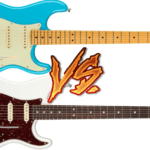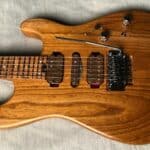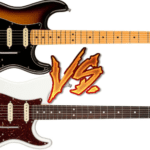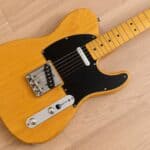Can you think of a more iconic guitar than a Stratocaster?
Since its inception, it has been one of, if not the most popular guitar models in the market.
It’s only natural that over the years a lot of different manufacturers tried their own takes on the instrument, resulting in different interesting variants.
Most commonly, when trying new things on an established guitar shape, innovation comes from trying out new materials.
But after all these variations, what is the best wood for a Stratocaster?
Original Stratocasters were made of alder or swamp ash, maple, and rosewood. These materials were selected because of their availability and quality in the early ’50s. Nowadays, it’s harder to find high-quality specimens, so manufacturers gravitate to alternative ones such as basswood or poplar.
In this article, I will discuss everything there is about the different tonewoods used in Stratocasters through the years, and why manufacturers might choose one over the others.
After leaving this page, you will have a clear idea about what materials work well for a Strat, and why builders tend to have gravitated to a particular set of them over the last decades.
Are you ready to get started?
Let’s go!
What makes for a great tonewood
Although tonewoods are debated among guitar players, especially for electric guitars, I’m a big proponent that they actually do make a difference.
However, we are not here to discuss that now.
Assuming that tonewoods are important for a guitar, it’s only natural to also accept that there might be different “qualities” of them in the wild.
And, although this quality I mention can be used to rank specific types of wood, or species (or anyway it should be said) such as Alder, Swamp Ash, Maple, Cedar, Rosewood, etc. or their different local variants (Indian rosewood, Brazilian rosewood) I also think about it within slabs of the same kind.
You see, you can find two pieces of comparable trees of Alder, however, one has been cut very recently and the other one was stored for 70 years.
In this case, you can expect that the older exemplar will probably be way better “stationed”, dryer, and more resonant for the use on a guitar.
This is a big tradeoff a lot of manufacturers have to think about nowadays with the current availability of woods, but I will touch on this later.
Legendary Strats were built with alder, swamp ash, and maple
The earliest models of the Stratocaster were dead simple: An ash body with a maple neck.
This simplicity had already worked for Fender with the Telecaster (or Broadcaster, or Squier), and the Strat was just a bit more out there with its double-cut design and tremolo system.
Materially, one could imagine that Leo Fender didn’t conduct a big series of lab tests to determine which tonewood combination would render the best upper mid-frequency output.
It was just a matter of what was available, and what was acceptable for use in a musical instrument in terms of quality and resonance.
Alder was incorporated in ‘56 for sunburst bodies, probably based on the same requirements as I mentioned.
In the ‘60s, the alternative of a rosewood fretboard was indeed an innovation.
And that was pretty much it.
Decades later, the resulting sound for that chance combination has been set as an industry standard and what most of us define as a Strat sound.
But a Stratocaster can be more than that.
Other alternatives
Manufacturers and even the Fender brand, over the years, have tried many different wood combinations for the model.
Some of them exploratory, such as rosewood bodies and necks, and others just to cut costs as the original materials became harder to come by.
Nowadays it’s not rare to find Stratocasters made of poplar, basswood, or alternatives such as agathis.
Laurel or pau ferro fretboards are also common, as well as baked maple ones.
The thing is, every material will give its own character to the instrument, and in many cases, it’s better to go for a high-quality alternative, than for cheap-furniture-grade slabs of the traditional ones
Quality vs availability
As I mentioned earlier, these days, with mass production in mind, manufacturers and artisans have to deal with a ubiquitous tradeoff between quality and availability.
Making a guitar with its vintage old specs it’s not economically possible in many cases, and in some others, not even legal.
From finishes to certain protected kinds of woods, manufacturers have to make compromises to deliver goods at a payable price point.
Alder, for instance, is a type of wood in high demand, and its production can’t keep up with the market needs.
Remember a tree can take about 20 years to be ready for processing.
This only causes available stocks to be young and not really well-fitted for guitar making.
A completely different scenario from what Fender had to deal with in the early ‘50s when the Stratocaster was first prototyped, and the woods they chose to make it were among the most affordable and easier to come by.
One could argue that if such a guitar was designed in the current times, its builders will probably gravitate to some alternative kind of wood that is currently commonly available in conditions suited for guitar-making, such as the ones mentioned above.
Conclusion
There is no best wood for a Stratocaster since it mostly depends on the quality of the current slabs available. When the original runs were made, ash, alder, maple, and rosewood were a great alternative, however, nowadays their quality is lacking. This is why manufacturers use substitute materials.

Hello there, my name is Ramiro and I’ve been playing guitar for almost 20 years. I’m obsessed with everything gear-related and I thought it might be worth sharing it. From guitars, pedals, amps, and synths to studio gear and production tips, I hope you find what I post here useful, and I’ll try my best to keep it entertaining also.





